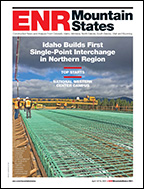The Missouri River flooding closed railroads as well as highways last summer, but U.S. railroad companies stayed a step ahead of the floodwaters, building levees and elevating tracks to keep their trains running.
Norfolk Southern Railway and Union Pacific Railroad raised track in Kansas and Missouri major floods within the past two decades, but the 2011 flood was so severe that they were again forced to elevate roadbeds.
“Due to major roadbed work after the 1993 flood and additional work after the 2007 flood our track did not require any additional raising,” said Robin Chapman, spokeswoman for Norfolk Southern. “If it had remained at the pre-’93 level we would have had 15 miles near Carrollton, Mo., under water by up to 2 feet,” she added.
Norfolk Southern has reinforced more than half of the 70 miles of track in its Kansas City district and, without that “would have suffered washout at locations that only had water on one side of the fills,” Chapman said.
While water was over much of the track from early June through late August, the line had only one washout, a 70-ft gap that required more than 4,000 tons of material, she said. The repair was completed in 17 hours. “We used a work train with side dump cars to unload over 550 cars of rip rap and also 400 cars of ballast,” using stone from local quarries and hiring contractors to haul it and fill the cars, she said.
Union Pacific had track closed in Missouri and Kansas, 21.4 miles between Kansas City and Jefferson City for 22 days in July and 12.75 miles between Atchison and Leavenworth for 26 days in late June and most of July, according to spokesman Mark Davis. Water was 16 in. above the top of the rails after a levee break in Missouri, but the signal equipment had been raised during earlier flooding so it was left in place, he said.
In Kansas, however, the water rose 36 in over a stretch of track that had already been raised 24 in, Davis said. Track signal components and components from signal houses were removed and replaced after the water receded, he said. Signal houses and equipment also were raised from 1 ft to 4 ft, depending on water levels.
The railroad raised almost 75 mi of track and raised or cleared nine bridges, Davis said. That took more than 458,000 tons, or 4,863 cars, of aggregate, 960 cars of rip rap and 3,840 cars of ballast.
BNSF Railway Co. raised tracks in Nebraska, Iowa and North Dakota in an effort to keep ahead of the flooding, elevating five miles of track near Pacific Junction, Iowa by as much as eight feet.
Crews also raised bridges and built 6-ft berms along 7 miles of track to prevent flooding. The railroad now plans to build five bridges in Missouri, where levee breaks forced track closings last summer.



Post a comment to this article
Report Abusive Comment